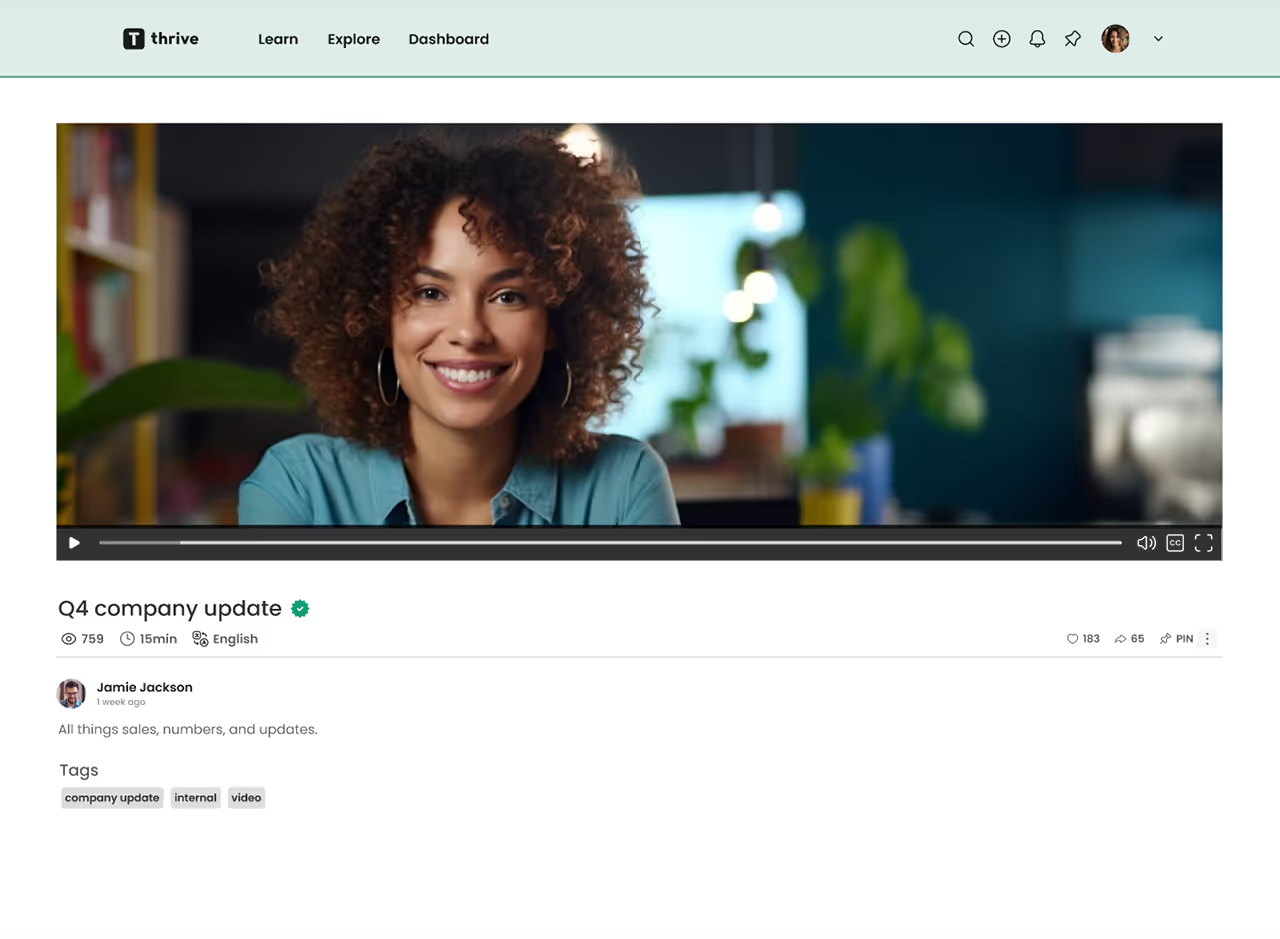Why your LMS should facilitate social learning
Social learning has so many benefits, and your platform should be set up to facilitate it. In this blog, we explore why social learning is so important and what that looks like in the workplace.

The social aspect of learning is non-negotiable, and your learning platform should facilitate it.
In this blog, we’ll explore why a learning platform with a social element is the key to effective learning experiences for your entire team - and what exactly that looks like on a practical level.
The theory of social learning emphasises the role that observation, imitation and modelling play in the learning process. In terms of workplace learning, this means that social and peer-to-peer interactions are just as important as formal, structured learning.
The Learning Experience Platform (LXP) originally aimed to capitalise on the need for social learning, putting the experiential element of learning front and centre. As time has gone on and needs have changed, we’ve gone through our very own learning platform evolution here at Thrive. Prior to our current positioning as “the all-in-one LMS”, we built our own LXP from the ground up - and prior to that, we were known simply as an LMS.
As we experiment, innovate and find out what works best for our customers, what we’ve discovered along the way is this: While LMS functionality is essential, the experiential elements of an LXP are just as non-negotiable. That’s why we’ve combined the best of both worlds with our current offering.
So, why is social learning such an important aspect of elearning? Let us count the reasons.
Why User Generated Content is important
One of the biggest cultural changes over the past decade or so is the birth - and acceptance - of User Generated Content (UGC.) Would you prefer to get recommendations from a brand, or a group of friends?
The fact is, people trust UGC more than traditional media. The stats don’t lie:
- 92% of people are more likely to trust a recommendation from another person over branded / official content
- 90% of consumers say authenticity is important
- 79% of people say UGC highly impacts their purchasing decisions
Consider this:
The last time you did - or didn’t - go to a restaurant because of other people’s reviews. A word-of-mouth recommendation for a particularly addictive reality TV show. The clothing sites that show real consumer photos within reviews, along with the ones produced by the brand. This is all UGC. It’s authentic, and comes without an agenda. Therefore, we’re much more likely to trust it.
This trend has had a huge impact on the way we learn.
For example, when I wanted to learn how to build my dog a house under the stairs, did I book a woodworking course that didn’t kick off for 2 months? No, I went straight to YouTube and found the exact information I needed from someone who had done it before.
And I’m not alone, because over 500 hours of video are consumed on YouTube every single minute. It’s the biggest UGC learning resource in the world, and that’s had a massive impact on our expectations.

Change in consumer expectations
Higher standards
As consumers, our expectations of technology and services have changed dramatically over the years. Personalisation and a good experience are now central to almost all the technology we interact with, whether that’s buying something online, browsing through Netflix, or dutifully collecting our end-of-year Spotify Wrapped stats.
Let’s go back to YouTube for a moment. Arguably, it actually lowered our expectations. Now that we’re so used to seeing UGC, it doesn’t really matter if the camera’s a bit shaky or if the person forgets what they’re saying halfway through - as long as the message gets across.
UGC is central to our everyday lives, and it should absolutely be a big part of how we learn. But naturally, it also seeps into our experiences at work, where technology is generally not on par with that of the consumer world.
Our learners are used to interacting with all this intuitive technology in their personal lives - for shopping, entertainment, and social media. So how do we think they’re going to feel when we ask them to use outdated, archaic tools at work?
If we want to keep them interested, we need to be making each employee’s working experience a delight by removing all barriers to getting their job done and keeping up with their expectations.
Experience: 67% of customers say their expectations for good experiences are higher than ever
Personalisation: 84% of customers say that being treated as a person and not a number is very important to them
Technological advancements
Better experiences
This seems like an obvious one, but it’s actually quite interesting. A lot of the technology we need to provide these improved experiences has been around for a pretty long time.
Amazon created the first non academic “item-based collaborative filtering algorithm” back in 1998, and it’s been improving ever since. Netflix gave it a big boost with the Netflix Prize, which challenged developers to improve their existing algorithm by 10% in exchange for a cash prize. This was awarded in 2009, and resulted in a huge amount of worldwide collaboration that’s had a real impact on algorithms today.
The main thing to take away is this: Although the concepts remain relatively unchanged since 1998, both our understanding of how to store, analyse and manipulate data, as well as the sheer amount of data we now have at our disposal, has changed dramatically.
In other words, data management is now a necessity.
What does social learning look like?
Now that we’ve explored why social learning is important, let’s take a look at how it works within a learning platform.
Allow personalisation
To satisfy our evolving expectations, personalisation should be at the core of the user’s experience. And this goes beyond just being able to change the layout of their front page; this is personalisation with a purpose. So important is personalisation, SalesForce found that consumers will gladly hand over data if it allows them a more personalised experience. The same applies here.
So how do we let our users have a personalised experience? And how can we use their behaviour to better recommend content?
Thrive (which has all the benefits of an LMS with the hyper-personalised, learner-led, social learning of an LXP) has a few different levels of personalisation:
- We ask users what they want to learn, and what they can teach others.
- We track behaviour to feed them content and people-based recommendations.
Encourage self-directed learning
While traditional LMSs are about the administrator being able to oversee and track learning, LXPs aim to address the end user, and how to give them the best experience possible.
We don’t see why both of these elements can’t work in tandem with each other: a learning platform that allows an administrator to track learning completions, and delivers the very best experience possible to the end user. Thrive is equipped to allow users to develop themselves in all sorts of subjects, above and beyond mandatory training tracked by the administrator. It’s not “you must do this training now,” it’s self-directed learning.
There are certain learning platform features that are absolutely built to support this way of learning:
- A way to find what they need: A great search lets learners find what they need, when they need it.
- A way to discover new content: In other words, browsing - much like we see on sites like Spotify.
- A way to explore things they might be interested in: Recommendations, to help users explore things they might be interested in.
Embrace all content
Speaking of content, it’s all well and good having a learning platform with these great discovery tools, but if you have no content to find, they immediately become pretty useless.
One of the challenges of the traditional LMS model being used for self-directed learning is that it’s closed off, restricted. Only admins can post, and when they do so it’s only internally created and approved content.
Part of social learning is philosophical. It’s about being more open to external content in general, and giving users the ability to embrace many different types of content - from multiple sources and vendors. Videos, files, links to TED talks, YouTube, online quizzes… the options are endless.
Promote user generated content
(Yes, again, it’s really that important.)
I could talk about the importance and benefits of UGC all day long. I truly believe the best knowledge in your business comes directly from the people actually doing the work. You don’t always need to scope it out, script it and formalise it into an official course.
Everyone has that one person in their team who makes you think, “if they left tomorrow, we’d be absolutely screwed.” UGC protects you against that, making sure important knowledge is shared across the business and not kept in silos.
Why not let people share what they know, in their own words, where and when it works for them? People trust UGC more than official content. It’s more authentic and passionate, and it’s in a language the learner understands.
We hope we’ve convinced you of the value that social learning can bring to your LMS. Explore how your organisation can evolve with your employees’ expectations, and drive better learner experiences with Thrive. We’d love to have a conversation with you.

